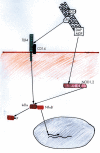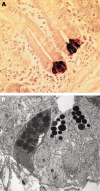Paneth cells: their role in innate immunity and inflammatory disease
- PMID: 16284290
- PMCID: PMC1774800
- DOI: 10.1136/gut.2005.068601
Paneth cells: their role in innate immunity and inflammatory disease
Figures





Similar articles
-
NOD2 mutations and Crohn's disease: are Paneth cells and their antimicrobial peptides the link?Gut. 2004 Nov;53(11):1558-60. doi: 10.1136/gut.2004.043307. Gut. 2004. PMID: 15479670 Free PMC article. Review. No abstract available.
-
Innate immune responses to commensal bacteria in the gut epithelium.J Pediatr Gastroenterol Nutr. 2008 Apr;46 Suppl 1:E10-1. doi: 10.1097/01.mpg.0000313823.93841.65. J Pediatr Gastroenterol Nutr. 2008. PMID: 18354312 Review. No abstract available.
-
Innate immunity in inflammatory bowel disease: state of the art.Curr Opin Gastroenterol. 2008 Jul;24(4):448-54. doi: 10.1097/MOG.0b013e3282ff8b0c. Curr Opin Gastroenterol. 2008. PMID: 18622158 Review.
-
Nucleotide-binding-oligomerization domain proteins and toll-like receptors: sensors of the inflammatory bowel diseases' microbial environment.Curr Opin Gastroenterol. 2005 Jul;21(4):419-25. Curr Opin Gastroenterol. 2005. PMID: 15930981 Review.
-
Paneth cells, defensins, and IBD.J Pediatr Gastroenterol Nutr. 2008 Apr;46 Suppl 1:E14-5. doi: 10.1097/01.mpg.0000313828.24337.d5. J Pediatr Gastroenterol Nutr. 2008. PMID: 18354317 Review. No abstract available.
Cited by
-
Oral transgenic plant-based vaccine for hepatitis B.Immunol Res. 2010 Mar;46(1-3):4-11. doi: 10.1007/s12026-009-8127-4. Immunol Res. 2010. PMID: 19756407 Review.
-
Gut commensal bacteria, Paneth cells and their relations to radiation enteropathy.World J Stem Cells. 2020 Mar 26;12(3):188-202. doi: 10.4252/wjsc.v12.i3.188. World J Stem Cells. 2020. PMID: 32266051 Free PMC article. Review.
-
Gut bacteria signaling to mitochondria in intestinal inflammation and cancer.Gut Microbes. 2020 May 3;11(3):285-304. doi: 10.1080/19490976.2019.1592421. Epub 2019 Mar 26. Gut Microbes. 2020. PMID: 30913966 Free PMC article. Review.
-
Differential expression of intestinal genes in necrotic enteritis challenged broiler chickens with 2 different Clostridium perfringens strains.Poult Sci. 2021 Mar;100(3):100886. doi: 10.1016/j.psj.2020.11.063. Epub 2020 Dec 3. Poult Sci. 2021. PMID: 33516477 Free PMC article.
-
Stem Cell Impairment at the Host-Microbiota Interface in Colorectal Cancer.Cancers (Basel). 2021 Feb 27;13(5):996. doi: 10.3390/cancers13050996. Cancers (Basel). 2021. PMID: 33673612 Free PMC article. Review.
References
-
- Justesen T, Nielsen OH, Jacobsen IE, et al. The normal cultivable microflora in upper jejunal fluid in healthy adults. Scand J Gastroenterol 1984;19:279–82. - PubMed
-
- Smith G, Gorbach S. Normal alimentary tract flora. In: Blaser M, Smith P, Ravidin J, eds. Infections of the gastrointestinal tract. New York: Raven Press, 1995:53–69.
-
- Medzhitov R, Janeway C Jr. Innate immunity. N Engl J Med 2000;343:338–44. - PubMed
-
- Brandtzaeg P, Pabst R. Let’s go mucosal: communication on slippery ground. Trends Immunol 2004;25:570–7. - PubMed
Publication types
MeSH terms
Substances
LinkOut - more resources
Full Text Sources
